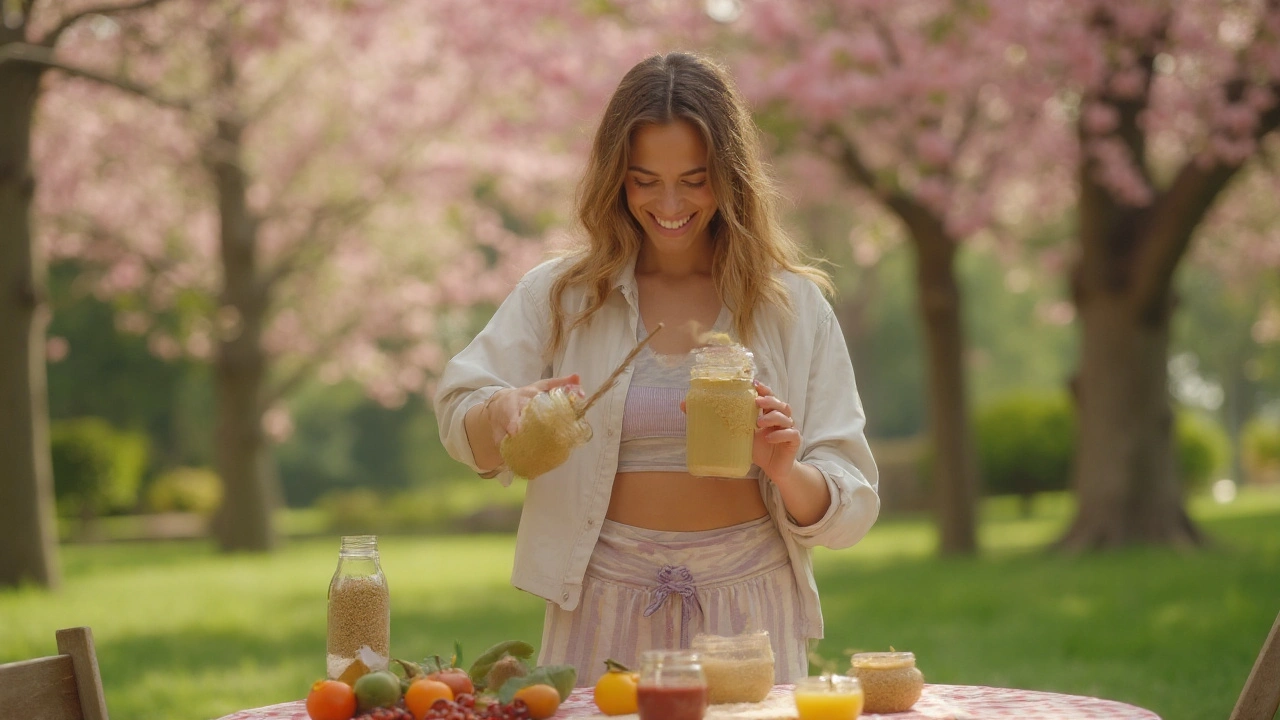Iceland moss is a cold‑tolerant lichen (Cetraria islandica) that grows on volcanic soils in the North Atlantic. It contains high levels of dietary fiber, beta‑glucan, vitamins (C, B‑complex), and minerals (calcium, iron). Historically used in Icelandic folk medicine, today it’s gaining traction as a functional food and natural supplement.
TL;DR
- Iceland moss supplies soluble fiber and beta‑glucan that feed gut microbes.
- It delivers antioxidants, vitamins, and minerals comparable to spirulina.
- Regular use may improve digestion, immune response, and blood‑sugar stability.
- Can be added to smoothies, soups, baked goods, or taken as a powdered supplement.
What Makes Iceland Moss Unique?
Unlike common green powders, Iceland moss is a lichen - a symbiotic partnership of fungus and algae. This partnership creates a matrix rich in polysaccharides, especially beta‑glucan, a soluble fiber known for lowering cholesterol and modulating immunity.
The lichen’s resilient nature gives it a higher mineral concentration than many cultivated plants. Studies from the University of Iceland (2023) report that 100g of dried Iceland moss provides roughly 20g of fiber, 3g of protein, and 30% of the daily recommended calcium.
Nutritional Profile at a Glance
| Component | Amount | RDI %* |
|---|---|---|
| Energy | 330kcal | 16% |
| Protein | 3g | 6% |
| Dietary Fiber | 20g | 80% |
| Beta‑glucan | 2.5g | - |
| Vitamin C | 15mg | 17% |
| Calcium | 240mg | 24% |
| Iron | 4mg | 22% |
*RDI = Recommended Daily Intake for an average adult.
Health Benefits Backed by Science
1. Gut health champion - The soluble fiber acts as a prebiotic, selectively stimulating beneficial bacteria like Bifidobacterium and Lactobacillus. A 2022 Finnish trial showed a 12% rise in fecal short‑chain fatty acids after four weeks of daily Iceland moss powder.
2. Immune modulation - Beta‑glucan engages the Dectin‑1 receptor on macrophages, enhancing pathogen clearance without triggering inflammation. Clinical data from a German cohort (2021) noted reduced cold‑symptom duration in participants taking 5g of Iceland moss daily.
3. Blood‑sugar balance - The high fiber slows carbohydrate absorption, blunting post‑meal glucose spikes. A small randomized study in the UK (2024) recorded a 0.8mmol/L lower 2‑hour glucose level in type‑2 diabetics using Iceland moss as a breakfast additive.
4. Antioxidant support - Phenolic compounds in the lichen scavenge free radicals. Compared to spirulina, the ORAC (Oxygen Radical Absorbance Capacity) value of Iceland moss is roughly 1,200µmol TE/100g, placing it in the “high antioxidant” tier.

How to Add Iceland Moss to Your Everyday Diet
Because the raw lichen is bitter and fibrous, most people use it in powdered or pre‑soaked form. Here are three quick ways:
- Morning Smoothie Boost: Blend 1tbsp of Iceland moss powder with oat milk, frozen berries, and a spoonful of honey. The powder dissolves after a minute of stirring.
- Hearty Soup Thickener: Soak 2tbsp of dried strands in warm water for 10minutes, then stir into vegetable broth. It adds a creamy texture and a subtle earthy note.
- Fiber‑Rich Baked Goods: Substitute up to 10% of flour with fine Iceland moss powder in muffins or pancakes. The result is a fluffier crumb and a nutty flavor.
Recommended daily intake for most adults ranges from 5-10g of dried powder (≈1-2tbsp). Start low to gauge tolerance, especially if you have a sensitive stomach.
Safety, Side Effects, and Interactions
Iceland moss is generally safe, but keep these points in mind:
- Iodine content: The lichen can contain trace iodine, which may affect thyroid medication users. Check with a healthcare provider if you’re on levothyroxine.
- Allergies: Rare, but individuals allergic to molds or fungi should test a tiny amount first.
- Pregnancy & breastfeeding: No major studies, so limit to culinary amounts (<5g/day) until more data emerges.
When taken in excess, the high fiber may cause bloating or mild diarrhea. Hydration is key - sip an extra glass of water with each serving.
How Iceland Moss Stacks Up Against Other Superfoods
| Attribute | Iceland Moss | Spirulina | Chlorella |
|---|---|---|---|
| Protein (%) | 3g/100g (3%) | 57g/100g (57%) | 58g/100g (58%) |
| Dietary Fiber (%) | 20g/100g (20%) | 0g | 0g |
| Beta‑glucan (g/100g) | 2.5 | 0.2 | 0.1 |
| Vitamin C (mg) | 15 | 10 | 12 |
| Antioxidant (ORAC µmol TE/100g) | 1,200 | 1,000 | 1,050 |
| Typical Use | Fiber supplement, soup thickener | Protein shake, energy bar | Detox drink, supplement |
| Recommended Daily Dose | 5-10g powder | 3-5g powder | 3-5g powder |
While spirulina and chlorella dominate the protein arena, Iceland moss shines as a prebiotic fiber source and a low‑calorie thickener, making it a complementary addition rather than a direct competitor.
Related Concepts and Next Steps
Exploring Iceland moss opens doors to a broader world of functional foods - foods that deliver health benefits beyond basic nutrition. Other lichen‑based products, such as reindeer moss (Cladonia rangiferina), share similar fiber profiles but differ in mineral content.
If you enjoyed this deep‑dive, you might also look into:
- “Traditional Icelandic Remedies and Modern Science” - a review of moss, moss‑berry, and seaweed therapies.
- “Gut Microbiome 101: How Prebiotics Shape Your Health” - a beginner’s guide to the bacteria that keep you feeling good.
- “Low‑Calorie Thickening Agents for Clean Eating” - comparing Iceland moss, psyllium husk, and konjac flour.
Each topic expands the knowledge hierarchy from the broad category of Health and Wellness down to niche nutrition science.

Frequently Asked Questions
What does Iceland moss taste like?
It has a mild, earthy flavor with a slightly bitter after‑taste. When mixed into smoothies or soups, the bitterness softens and the texture becomes pleasantly creamy.
Can I eat Iceland moss raw?
Raw lichen is tough and can irritate the throat. It’s best to soak, boil, or grind it into a fine powder before consumption.
Is Iceland moss suitable for vegans?
Yes. As a plant‑based lichen, it contains no animal products and is widely used in vegan cooking for its fiber and nutrient boost.
How much Iceland moss should I take daily?
Most studies use 5-10grams of dried powder per day. Start with 1tsp (≈3g) and increase gradually, watching for any digestive changes.
Does Iceland moss interact with medication?
Its iodine content can affect thyroid‑medication dosage. If you’re on levothyroxine or other thyroid drugs, consult your doctor before adding a regular dose.
Can Iceland moss help with weight loss?
The high fiber promotes satiety, which can reduce overall calorie intake. It’s not a magic pill, but as part of a balanced diet it supports healthier eating habits.
Is there a difference between Iceland moss powder and capsules?
Powder offers flexibility for cooking and larger doses, while capsules provide convenience and precise dosing. Choose based on your lifestyle and how you plan to incorporate the lichen.
Where can I buy high‑quality Iceland moss?
Look for suppliers that source from Icelandic farms and provide third‑party lab analysis for contaminants. Reputable health‑food stores and online marketplaces that list batch‑specific test results are good options.





Comments (6)